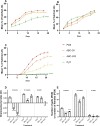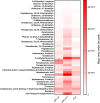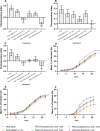ABC transporter genes ABC-C6 and ABC-G33 alter plant-microbe-parasite interactions in the rhizosphere
- PMID: 31882903
- PMCID: PMC6934816
- DOI: 10.1038/s41598-019-56493-w
ABC transporter genes ABC-C6 and ABC-G33 alter plant-microbe-parasite interactions in the rhizosphere
Abstract
Plants are master regulators of rhizosphere ecology, secreting a complex mixture of compounds into the soil, collectively termed plant root exudate. Root exudate composition is highly dynamic and functional, mediating economically important interactions between plants and a wide range of soil organisms. Currently we know very little about the molecular basis of root exudate composition, which is a key hurdle to functional exploitation of root exudates for crop improvement. Root expressed transporters modulate exudate composition and could be manipulated to develop beneficial plant root exudate traits. Using Virus Induced Gene silencing (VIGS), we demonstrate that knockdown of two root-expressed ABC transporter genes in tomato cv. Moneymaker, ABC-C6 and ABC-G33, alters the composition of semi-volatile compounds in collected root exudates. Root exudate chemotaxis assays demonstrate that knockdown of each transporter gene triggers the repulsion of economically relevant Meloidogyne and Globodera spp. plant parasitic nematodes, which are attracted to control treatment root exudates. Knockdown of ABC-C6 inhibits egg hatching of Meloidogyne and Globodera spp., relative to controls. Knockdown of ABC-G33 has no impact on egg hatching of Meloidogyne spp. but has a substantial inhibitory impact on egg hatching of G. pallida. ABC-C6 knockdown has no impact on the attraction of the plant pathogen Agrobacterium tumefaciens, or the plant growth promoting Bacillus subtilis, relative to controls. Silencing ABC-G33 induces a statistically significant reduction in attraction of B. subtilis, with no impact on attraction of A. tumefaciens. By inoculating selected differentially exuded compounds into control root exudates, we demonstrate that hexadecaonic acid and pentadecane are biologically relevant parasite repellents. ABC-C6 represents a promising target for breeding or biotechnology intervention strategies as gene knockdown leads to the repulsion of economically important plant parasites and retains attraction of the beneficial rhizobacterium B. subtilis. This study exposes the link between ABC transporters, root exudate composition, and ex planta interactions with agriculturally and economically relevant rhizosphere organisms, paving the way for new approaches to rhizosphere engineering and crop protection.
Conflict of interest statement
The authors declare no competing interests.
Figures





Similar articles
-
Ethylene Response Factor (ERF) genes modulate plant root exudate composition and the attraction of plant parasitic nematodes.Int J Parasitol. 2019 Dec;49(13-14):999-1003. doi: 10.1016/j.ijpara.2019.09.001. Epub 2019 Nov 11. Int J Parasitol. 2019. PMID: 31726058
-
Exogenous RNA interference exposes contrasting roles for sugar exudation in host-finding by plant pathogens.Int J Parasitol. 2016 Jul;46(8):473-7. doi: 10.1016/j.ijpara.2016.02.005. Epub 2016 Mar 29. Int J Parasitol. 2016. PMID: 27033013
-
Lauric acid in crown daisy root exudate potently regulates root-knot nematode chemotaxis and disrupts Mi-flp-18 expression to block infection.J Exp Bot. 2014 Jan;65(1):131-41. doi: 10.1093/jxb/ert356. Epub 2013 Oct 29. J Exp Bot. 2014. PMID: 24170741 Free PMC article.
-
Chemotaxis of Beneficial Rhizobacteria to Root Exudates: The First Step towards Root-Microbe Rhizosphere Interactions.Int J Mol Sci. 2021 Jun 22;22(13):6655. doi: 10.3390/ijms22136655. Int J Mol Sci. 2021. PMID: 34206311 Free PMC article. Review.
-
Root exudates: from plant to rhizosphere and beyond.Plant Cell Rep. 2020 Jan;39(1):3-17. doi: 10.1007/s00299-019-02447-5. Epub 2019 Jul 25. Plant Cell Rep. 2020. PMID: 31346716 Review.
Cited by
-
Multi-omics analysis of soil microbiota and metabolites in dryland wheat fields under different tillage methods.Sci Rep. 2024 Oct 14;14(1):24066. doi: 10.1038/s41598-024-74620-0. Sci Rep. 2024. PMID: 39402065 Free PMC article.
-
The effects of different types of calorie restrictions on epigenetic modifications of age-related genes in aging mouse brain.Biogerontology. 2025 Aug 4;26(4):154. doi: 10.1007/s10522-025-10297-w. Biogerontology. 2025. PMID: 40760208
-
The chromosome-scale reference genome and transcriptome analysis of Solanum torvum provides insights into resistance to root-knot nematodes.Front Plant Sci. 2023 Jul 17;14:1210513. doi: 10.3389/fpls.2023.1210513. eCollection 2023. Front Plant Sci. 2023. PMID: 37528971 Free PMC article.
-
Comparative Functional Genome Analysis Reveals the Habitat Adaptation and Biocontrol Characteristics of Plant Growth-Promoting Bacteria in NCBI Databases.Microbiol Spectr. 2023 Jun 15;11(3):e0500722. doi: 10.1128/spectrum.05007-22. Epub 2023 Apr 26. Microbiol Spectr. 2023. PMID: 37098923 Free PMC article.
-
Choreographing root architecture and rhizosphere interactions through synthetic biology.Nat Commun. 2024 Feb 14;15(1):1370. doi: 10.1038/s41467-024-45272-5. Nat Commun. 2024. PMID: 38355570 Free PMC article. Review.
References
MeSH terms
Substances
LinkOut - more resources
Full Text Sources
Molecular Biology Databases
Miscellaneous

